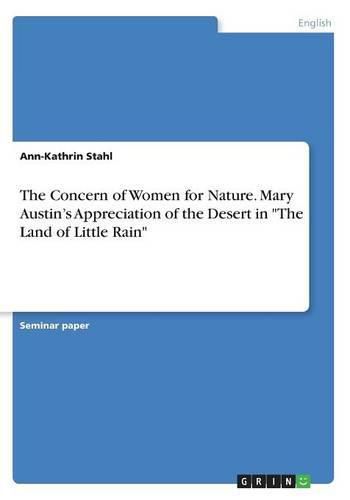Readings Newsletter
Become a Readings Member to make your shopping experience even easier.
Sign in or sign up for free!
You’re not far away from qualifying for FREE standard shipping within Australia
You’ve qualified for FREE standard shipping within Australia
The cart is loading…






Seminar paper from the year 2014 in the subject American Studies - Literature, grade: 1,0, Johannes Gutenberg University Mainz, language: English, abstract: In response to the industrial revolution of the late 18th century (Scheese 6) a new field of literary studies has been established. Derived from former pastoralism, authors now engage into what is called ‘nature writing’. Addressing the concerns of life in the country, attention is directed to the different forms of nature as well. One of these nature writers can be found in Mary Hunter Austin, an American writer who expresses her affinity for nature, and more particularly the desert (Scheese 76) by describing the landscape of the Mojave Desert in Southern California the way she perceived it during her walks through it. Austin successfully creates a whole new picture of it in her work The Land of Little Rain . Through her celebration of a land often perceived as sterile and uninteresting, Austin helped create in America what had not existed before the turn of the century: a desert aesthetic. What Scheese here calls a desert aesthetic (Scheese 75) describes the establishment of a literary discourse exclusively centered around literature about the desert. Desert literature itself offers numerous possibilities for writers at the beginning of the twentieth century, especially for female writers as it inspired cultural fantasies and enabled real and imagined experiences of solitude, comntemplative repose, divine revelation (Gersdorf 16). As a consequence, the stories of female writers can be understood as symbolic since the action is moved from a former domestic space to the public sphere in form of the desert. This also conforms to the character of the concept of ‘New Womanhood’ which signifies a newly gained freedom for women at the end of the nineteenth century as their determination of staying within the domestic sphere was finally abandoned. To prove this statement, the following essay initially gi
$9.00 standard shipping within Australia
FREE standard shipping within Australia for orders over $100.00
Express & International shipping calculated at checkout
Seminar paper from the year 2014 in the subject American Studies - Literature, grade: 1,0, Johannes Gutenberg University Mainz, language: English, abstract: In response to the industrial revolution of the late 18th century (Scheese 6) a new field of literary studies has been established. Derived from former pastoralism, authors now engage into what is called ‘nature writing’. Addressing the concerns of life in the country, attention is directed to the different forms of nature as well. One of these nature writers can be found in Mary Hunter Austin, an American writer who expresses her affinity for nature, and more particularly the desert (Scheese 76) by describing the landscape of the Mojave Desert in Southern California the way she perceived it during her walks through it. Austin successfully creates a whole new picture of it in her work The Land of Little Rain . Through her celebration of a land often perceived as sterile and uninteresting, Austin helped create in America what had not existed before the turn of the century: a desert aesthetic. What Scheese here calls a desert aesthetic (Scheese 75) describes the establishment of a literary discourse exclusively centered around literature about the desert. Desert literature itself offers numerous possibilities for writers at the beginning of the twentieth century, especially for female writers as it inspired cultural fantasies and enabled real and imagined experiences of solitude, comntemplative repose, divine revelation (Gersdorf 16). As a consequence, the stories of female writers can be understood as symbolic since the action is moved from a former domestic space to the public sphere in form of the desert. This also conforms to the character of the concept of ‘New Womanhood’ which signifies a newly gained freedom for women at the end of the nineteenth century as their determination of staying within the domestic sphere was finally abandoned. To prove this statement, the following essay initially gi